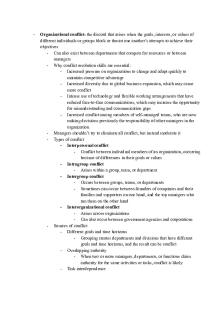Online Notes PDF

| Title | Online Notes |
|---|---|
| Author | Alex Garcia |
| Course | Statistics for Business and Economics |
| Institution | Florida International University |
| Pages | 5 |
| File Size | 352 KB |
| File Type | |
| Total Downloads | 36 |
| Total Views | 149 |
Summary
Just some online notes useful stuff from the online textbook and assignments on MyStatLab...
Description
5.3 Two events are disjoint if they have no outcomes in common. In other words, the events are disjoint if, knowing that one of the events occurs, we know the other event did not occur. Independence means that one event occurring does not affect the probability of the other event occurring. Therefore, knowing two events are disjoint means that the events are not independent.
The notation P(F|E) is read “the probability of event F given event E.” It is the conditional probability that event F occurs, given that event E has occurred.
Conditional Probability Rule If
E and F are any two events, then P(F|E)=P(E and F)P(E)=N(E and F)N(E)
The probability of event
F occurring, given the occurrence of event E, is found by
dividing the probability of outcomes in
E and F by the probability of E, or by dividing the number of
E and F by the number of outcomes in E.
6.1 A continuous variable is a quantitative variable that has an infinite number of possible values that are not countable and a discrete variable is a quantitative variable that has either a finite number of possible values or a countable number of possible values. A continuous variable may take on every possible value between any two values, while a discrete variable cannot.
The probability distribution of a discrete random variable X provides the possible values of the random variable and their corresponding probabilities. A probability distribution can be in the form of a table, graph, or mathematical formula. In the graph of a discrete probability distribution, the horizontal axis is the value of the discrete random variable and the vertical axis is the corresponding probability of the discrete random variable. When graphing a discrete probability distribution, we want to emphasize that the data are discrete. Therefore, draw the graph of discrete probability distributions using vertical lines above each value of the random variable to a height that is the probability of the random variable. EX
Suppose a life insurance company sells a $240,000 one year term life insurance policy to a 25-year old female for $210. The probability that the female survives
the year is .999592. Compute the expected value of this policy to the insurance company.
($210)(0.999592)−($239790)(0.000408)
==== ANSWER...
Similar Free PDFs

Online Notes
- 5 Pages

STAT1201 Online Learning Notes
- 29 Pages

Session 2 Online Class Notes
- 4 Pages

labsim online notes chapter 1
- 6 Pages

Session 3 Online Class Notes 1-1
- 4 Pages
Popular Institutions
- Tinajero National High School - Annex
- Politeknik Caltex Riau
- Yokohama City University
- SGT University
- University of Al-Qadisiyah
- Divine Word College of Vigan
- Techniek College Rotterdam
- Universidade de Santiago
- Universiti Teknologi MARA Cawangan Johor Kampus Pasir Gudang
- Poltekkes Kemenkes Yogyakarta
- Baguio City National High School
- Colegio san marcos
- preparatoria uno
- Centro de Bachillerato Tecnológico Industrial y de Servicios No. 107
- Dalian Maritime University
- Quang Trung Secondary School
- Colegio Tecnológico en Informática
- Corporación Regional de Educación Superior
- Grupo CEDVA
- Dar Al Uloom University
- Centro de Estudios Preuniversitarios de la Universidad Nacional de Ingeniería
- 上智大学
- Aakash International School, Nuna Majara
- San Felipe Neri Catholic School
- Kang Chiao International School - New Taipei City
- Misamis Occidental National High School
- Institución Educativa Escuela Normal Juan Ladrilleros
- Kolehiyo ng Pantukan
- Batanes State College
- Instituto Continental
- Sekolah Menengah Kejuruan Kesehatan Kaltara (Tarakan)
- Colegio de La Inmaculada Concepcion - Cebu










